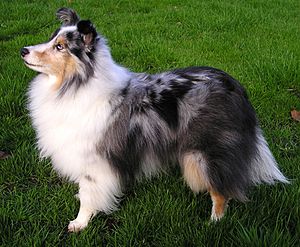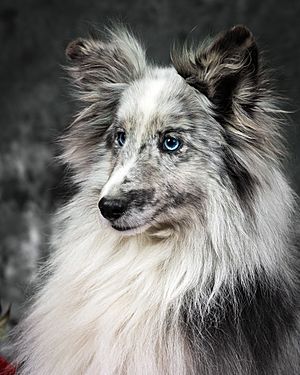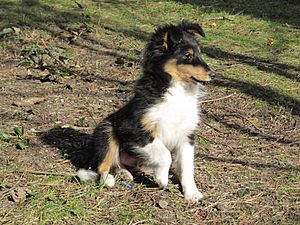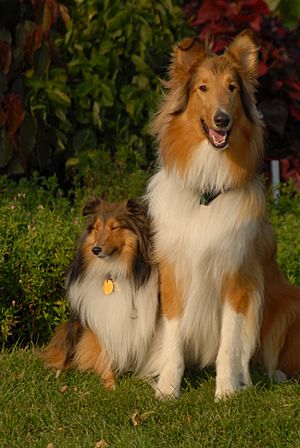Shetland Sheepdog facts for kids
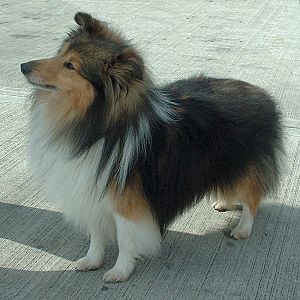
Sable Shetland Sheepdog
|
|||||||||||||||||||||||||||||||||
| Other names | Shetland Collie (obsolete) Dwarf Scotch Shepherd (obsolete) |
||||||||||||||||||||||||||||||||
|---|---|---|---|---|---|---|---|---|---|---|---|---|---|---|---|---|---|---|---|---|---|---|---|---|---|---|---|---|---|---|---|---|---|
| Common nicknames | Sheltie | ||||||||||||||||||||||||||||||||
| Origin | Scotland | ||||||||||||||||||||||||||||||||
|
|||||||||||||||||||||||||||||||||
|
|||||||||||||||||||||||||||||||||
| Domestic dog (Canis lupus familiaris) | |||||||||||||||||||||||||||||||||
The Shetland Sheepdog, often called the Sheltie, is a smart and loyal dog breed. It comes from the Shetland Islands in Scotland. These dogs are known for being very attached to their families. People sometimes call them "shadows" because they love to be close to their owners.
Shelties are great at herding animals, but today many are also loved as family pets. They are small but tough, just like other animals from the Shetland Islands, such as the Shetland pony. This breed was officially recognized by The Kennel Club in the UK in 1909.
Shelties look a lot like a smaller version of the Rough Collie. However, they are not directly related. Instead, they came from smaller Collies and other breeds like the King Charles Spaniel. Early Shelties were small mixed-breed dogs. Over time, breeders helped create the modern Shetland Sheepdog we know today.
Contents
History of the Sheltie Breed
The Shetland Sheepdog was not just made by breeding smaller Rough Collies. The first sheepdogs on Shetland were a different type of dog, perhaps like the Icelandic Sheepdog. These dogs were then mixed with working collies from mainland Britain. Later, in England, they were further mixed with Rough Collies and other breeds. These might have included the King Charles Spaniel and the Pomeranian.
The original Shetland sheepdog is now gone. Today, Border Collies are mostly used for herding on the islands. Shelties were used for herding until bigger dogs were needed for large farms.
When the breed was first introduced, people called them Shetland Collies. This made breeders of Rough Collies upset. So, the name was changed to Shetland Sheepdog. In the early 1900s, some Rough Collies were still bred with Shelties. This helped keep the Sheltie looking like a smaller Rough Collie.
The English Kennel Club first recognized the Sheltie in 1909. The first Sheltie registered was a female named Badenock Rose. In 1911, the first Sheltie registered by the American Kennel Club was "Lord Scott."
What Shelties Look Like
Shelties generally look like smaller versions of the Rough Collie. They are small, strong working dogs with two layers of fur. Blue merle Shelties can have blue eyes or one blue and one brown eye. Other Shelties usually have dark brown eyes.
Their faces show that they are alert and gentle. They can be a bit shy with strangers but should not be timid. Shelties are often very good with children. They usually carry their tail low, only lifting it when they are excited or alert.
Sheltie Coat and Colors
Shelties have a double coat. This means they have two layers of fur. The top layer has long, rough hairs that keep water out. The bottom layer is thick and soft. This undercoat helps them stay warm in cold weather and cool in hot weather.
The English Kennel Club lists three main colors for Shelties. These are tricolor, blue merle, and sable. Sable colors can range from golden to a deep reddish-brown. All these colors can have different amounts of white or tan markings.
- Sable: This is a common color. It can be a light golden or a dark mahogany brown.
- Tricolor: These dogs are black, white, and tan.
- Bi-black: These Shelties are black and white.
Special Coat Colors
Some Shelties have special colors because of certain genes. These genes can change the basic colors.
- Blue Merle: These dogs are blue, white, and tan. They are like a tricolor dog but with a merling gene. This gene makes their black fur look mixed with grey and white patches. Blue merle Shelties can have blue eyes.
- Bi-blue: These Shelties are blue and white. They are like a bi-black dog with the merling gene. They can also have blue eyes.
- Sable Merle: These dogs have a faded or mottled sable color. They might look like a lighter sable or a washed-out blue merle.
Some Shelties can also be color-headed whites. These dogs have a colored head (like sable or tricolor) but mostly white bodies. They are healthy and normal, but they are not usually shown in dog shows if they are more than 50 percent white.
It is important to know about double merles. These puppies are born when two merle Shelties are bred together. Double merles often have serious health problems, such as being deaf or blind.
Size and Weight
Shelties usually weigh between 5 and 11 kilograms (11 to 24 pounds). Male Shelties are generally a bit taller and heavier than females.
In the USA and Canada, Shelties should be between 33 and 41 centimeters (13 to 16 inches) tall at the shoulder. In other countries like Australia, New Zealand, and the UK, males should be around 37 cm (14.5 inches) and females around 35.5 cm (14 inches). Some Shelties might be outside these ranges, but they are not considered typical for the breed.
Sheltie Ears
For Shelties to meet breed standards, their ears should have a slight bend or "tip" at the top. This gives them the "proper Sheltie expression." The top one-third to one-quarter of the ear should tip forward. If a Sheltie's ears stand straight up, some owners might gently brace them to help them tip correctly. Ears that are too far apart or tip too low are not preferred.
Grooming Your Sheltie
Shelties have a double coat and shed fur quite often, no matter the season. The topcoat is long and straight, helping to keep water out. The undercoat is short, soft, and very thick, which keeps the dog warm.
Mats (tangles) can often form behind their ears, under their front legs, and in the fluffy fur on their back legs. They also get mats around their collar. Shelties usually shed a lot of fur twice a year, often in spring and autumn. Female Shelties also shed a lot right before or after having puppies. Male Shelties shed less than females, but they still lose fur constantly. Regular brushing is important to keep their coat healthy and prevent mats.
Sheltie Temperament and Intelligence
Shelties are known for being very smart dogs. According to Dr. Stanley Coren, who studies animal intelligence, the Shetland Sheepdog is one of the "brightest dogs." He ranked them 6th out of 138 dog breeds tested.
His research showed that an average Sheltie could learn a new command very quickly, often in fewer than five tries. They would also obey a command almost every time it was given. This high intelligence makes them easy to train for many activities.
|
See also
 In Spanish: Pastor de las islas Shetland para niños
In Spanish: Pastor de las islas Shetland para niños




